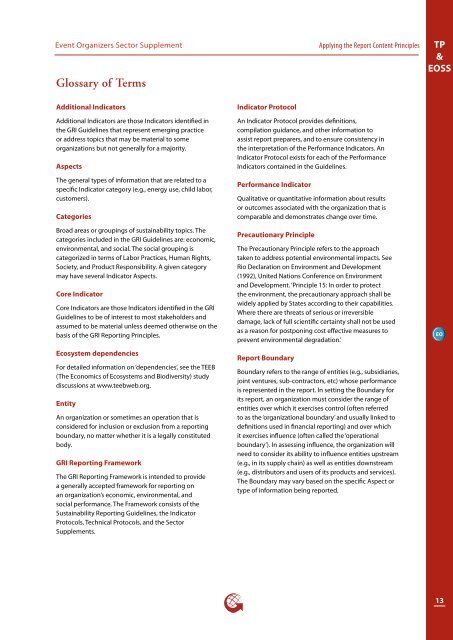Event Organizers Sector Supplement - Global Reporting Initiative
Event Organizers Sector Supplement - Global Reporting Initiative
Event Organizers Sector Supplement - Global Reporting Initiative
Create successful ePaper yourself
Turn your PDF publications into a flip-book with our unique Google optimized e-Paper software.
<strong>Event</strong> <strong>Organizers</strong> <strong>Sector</strong> <strong>Supplement</strong><br />
Glossary of Terms<br />
Applying the Report Content Principles<br />
TP<br />
&<br />
EOSS<br />
Additional Indicators<br />
Additional Indicators are those Indicators identified in<br />
the GRI Guidelines that represent emerging practice<br />
or address topics that may be material to some<br />
organizations but not generally for a majority.<br />
Aspects<br />
The general types of information that are related to a<br />
specific Indicator category (e.g., energy use, child labor,<br />
customers).<br />
Categories<br />
Broad areas or groupings of sustainability topics. The<br />
categories included in the GRI Guidelines are: economic,<br />
environmental, and social. The social grouping is<br />
categorized in terms of Labor Practices, Human Rights,<br />
Society, and Product Responsibility. A given category<br />
may have several Indicator Aspects.<br />
Core Indicator<br />
Core Indicators are those Indicators identified in the GRI<br />
Guidelines to be of interest to most stakeholders and<br />
assumed to be material unless deemed otherwise on the<br />
basis of the GRI <strong>Reporting</strong> Principles.<br />
Ecosystem dependencies<br />
For detailed information on ‘dependencies’, see the TEEB<br />
(The Economics of Ecosystems and Biodiversity) study<br />
discussions at www.teebweb.org.<br />
Entity<br />
An organization or sometimes an operation that is<br />
considered for inclusion or exclusion from a reporting<br />
boundary, no matter whether it is a legally constituted<br />
body.<br />
GRI <strong>Reporting</strong> Framework<br />
The GRI <strong>Reporting</strong> Framework is intended to provide<br />
a generally accepted framework for reporting on<br />
an organization’s economic, environmental, and<br />
social performance. The Framework consists of the<br />
Sustainability <strong>Reporting</strong> Guidelines, the Indicator<br />
Protocols, Technical Protocols, and the <strong>Sector</strong><br />
<strong>Supplement</strong>s.<br />
Indicator Protocol<br />
An Indicator Protocol provides definitions,<br />
compilation guidance, and other information to<br />
assist report preparers, and to ensure consistency in<br />
the interpretation of the Performance Indicators. An<br />
Indicator Protocol exists for each of the Performance<br />
Indicators contained in the Guidelines.<br />
Performance Indicator<br />
Qualitative or quantitative information about results<br />
or outcomes associated with the organization that is<br />
comparable and demonstrates change over time.<br />
Precautionary Principle<br />
The Precautionary Principle refers to the approach<br />
taken to address potential environmental impacts. See<br />
Rio Declaration on Environment and Development<br />
(1992), United Nations Conference on Environment<br />
and Development. ‘Principle 15: In order to protect<br />
the environment, the precautionary approach shall be<br />
widely applied by States according to their capabilities.<br />
Where there are threats of serious or irreversible<br />
damage, lack of full scientific certainty shall not be used<br />
as a reason for postponing cost effective measures to<br />
prevent environmental degradation.’<br />
Report Boundary<br />
Boundary refers to the range of entities (e.g., subsidiaries,<br />
joint ventures, sub-contractors, etc) whose performance<br />
is represented in the report. In setting the Boundary for<br />
its report, an organization must consider the range of<br />
entities over which it exercises control (often referred<br />
to as the ‘organizational boundary’ and usually linked to<br />
definitions used in financial reporting) and over which<br />
it exercises influence (often called the ‘operational<br />
boundary’). In assessing influence, the organization will<br />
need to consider its ability to influence entities upstream<br />
(e.g., in its supply chain) as well as entities downstream<br />
(e.g., distributors and users of its products and services).<br />
The Boundary may vary based on the specific Aspect or<br />
type of information being reported.<br />
EO<br />
13

















